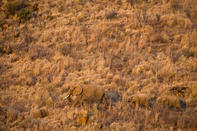
With the proclamation of the Pilanesberg National Park in South Africa's North West Province, a decision was made to have a mass translocation of animals into the area, instead of a gradual restocking.
Although there were species, such as leopard that occurred naturally in the Pilanesberg area, it was decided to re-introduce the species that had occurred in the area historically. So began Operation Genesis - the largest translocation of animals in the world at that time.
High Concentrations of Wild Animals
From 1979, more than 6,000 animals of various species were moved into quarantine enclosures to acclimatise before being released. All internal fences were pulled down, giving rise to today's Pilanesberg National Park, a self-sustaining game reserve. Major predators such as lions were introduced into the ecosystem in the early 1990s and have adapted well to the environment.
Such is the success of Pilanesberg National Park that today it boasts the highest concentration of rhinos per square kilometre in Africa. Most visitors will remark that they saw more rhinos on their game drives in Pilanesberg than the ever-plentiful impala. This may be a small exaggeration but it is true to say that the park has more rhino than elephant - a fact that is unique among the larger wildlife reserves of Africa.
Strange Behaviour and Other Species
Operation Genesis was, on the whole, a very successful operation, but there were some interesting side-effects. As part of the original translocation, young elephant that were saved from a cull in the Kruger National Park were introduced into Pilanesberg.
As these elephant reached sexual maturity the males began to show strange behaviour. Rhino fatalities increased dramatically.
It was only after many rhino had died that it was discovered that the elephants were trying to mount the rhino, and in their aggression at been continuously rejected they were killing their unwilling partners!
Under normal circumstances adult elephant teach the youngsters as they grow, but in the case of Operation Genesis all the introduced elephant were young and there was no adult supervision.
The authorities decided to introduce adult elephant into the reserve in an attempt to check the rhino fatalities. The results were immediate and rhino fatalities decreased dramatically as the adult elephants took control of the youngsters.
Pilanesberg Today
The Pilanesberg National Park serves as an example of how land can successfully be returned to its natural state, and how communities can benefit from wilderness conservation.

 Just a short drive from Gauteng's two major cities; Johannesburg and Pretoria, travellers will be able to enjoy a Big Five safari experience...
Just a short drive from Gauteng's two major cities; Johannesburg and Pretoria, travellers will be able to enjoy a Big Five safari experience... Malaria-free Pilanesberg National Park, adjacent to Sun City Resort, is situated in a long extinct volcano. Spot Big Five in one of the larg...
Malaria-free Pilanesberg National Park, adjacent to Sun City Resort, is situated in a long extinct volcano. Spot Big Five in one of the larg...